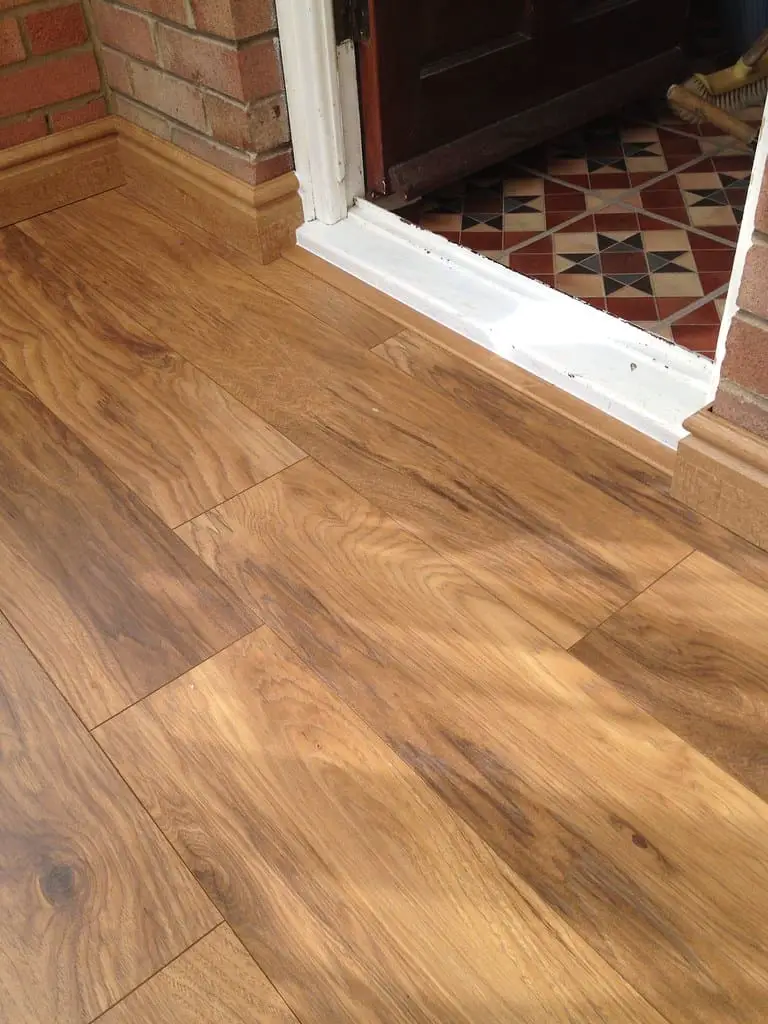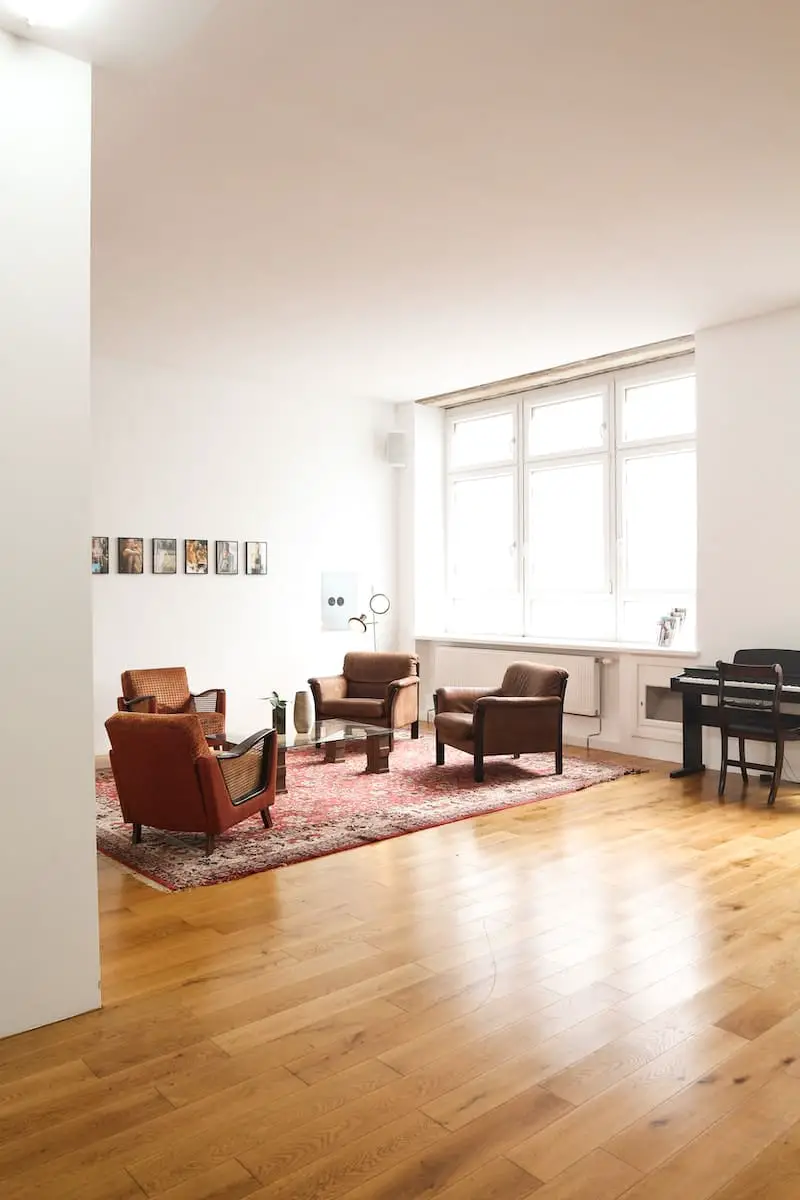Laminate Flooring is manufactured by putting a core layer of the board composed of wood byproducts in the production process.
A layer is added on top of this to make it look like wood or similar materials. Wooden flooring is produced by interlocking flooring boards made of real wood.
Solid hardwood flooring boards are really attractive and provide customers with a quality and realistic material experience.
Even the most affordable wood flooring patterns are more appealing than laminate flooring patterns.
Key Takeaways
- Laminate flooring is a synthetic product made of multiple layers of materials, while wooden flooring is made of solid wood.
- Laminate flooring is less expensive and easier to install than wooden flooring.
- Wooden flooring can be sanded and refinished, while laminate flooring cannot be refinished and must be replaced when worn.
Laminate Flooring vs Wooden Flooring
Laminate flooring is a type of flooring that has thinner flooring boards that are 6 to 12 mm thick. They have click-lock edges that assist secure the boards. Wooden flooring boards, are flooring boards that are 3/4 inch thick. The flooring boards are blind-nailed during installation.

Laminate Flooring is manufactured by layering a core layer of the board made of wood byproducts.
Above that, a layer is applied to make it appear as if it were made of wood or similar materials.
Laminate flooring is widely regarded as the greatest alternative to wood flooring.
They do, however, endeavor to replicate the wooden floors to the best extent possible and are somewhat successful.
Wooden flooring is constructed by laying genuine wooden flooring planks through and through.
Even the most affordable types of timber flooring are more appealing than laminate flooring patterns.
The placement of wooden flooring boards away from direct water contact is advised.
The quality of these boards deteriorates when they come into touch with flood or standing water.
Wooden flooring is not capable of withstanding heat for an extended period.
Comparison Table
| Parameters of Comparison | Laminate Flooring | Wooden Flooring |
|---|---|---|
| Price | Less expensive | More expensive |
| Life span | Less | More |
| Durability | Less | More |
| Weight | Less | More |
| Water, heat resistant | Yes | No |
| Appearance | Relatively less attractive | More attractive |
What is Laminate Flooring?
The majority of laminate flooring boards are stained and water-resistant. If the water seeps into the joints, though, the area may enlarge and chip.
Heat resistance is excellent in laminate flooring patterns. As a result, they can be used in conjunction with radiant heating systems.
With the help of a brush or vacuum, laminate flooring can be simply cleaned.
They may be mopped well with the help of a laminate floor cleaner. These floors don’t need to be waxed.
They’ve been built with click-lock edges to help keep the boards secure. There is no need to use glue or nails with these flooring boards.
Laminate flooring is widely regarded as the greatest alternative to hardwood flooring.
They do, however, endeavor to replicate the wooden floors to the greatest extent possible and are somewhat successful.
Laminate Flooring is manufactured by layering a core layer of the board formed of wood leftovers during the production process.
Above that, a coating is applied to make it resemble wood or similar materials.
Laminate flooring, on the other hand, has thinner flooring boards that are 6 to 12 mm thick.
However, they do not have the same appealing aspect as timber floors.

What is Wooden Flooring?
Wooden flooring cannot withstand heat for an extended period. The boards may shrink, causing the joints to open up.
Cleaning wooden floors, cleaning them, or even sweeping them would make a huge difference. They can also be cleaned with the help of a wood cleaner.
Solid hardwood flooring boards are incredibly beautiful and provide customers with a quality and real material feel.
Even the most affordable types of wood flooring are more appealing than laminate flooring patterns. The placement of wooden flooring boards away from direct water contact is advised.
Wooden flooring is formed by laying down flooring boards composed of actual wood material all the way through.
The thickness of the wooden flooring boards is normally 3/4 inches. The wooden boards are frequently linked to keeping them in place.
The flooring planks are blind-nailed throughout the installation procedure.
The quality of these boards degrades when they come into touch with flood or standing water.

Main Differences Between Laminate Flooring and Wooden Flooring
- The manufacturing process of Laminate Flooring is done by placing a core layer of the board, which is made up of byproducts of wood. Above this, a layer is designed to make it look like wooden or relative materials. On the other hand, Wooden Flooring is manufactured by placing the flooring boards, which are made up of genuine wooden material, placed through and through.
- In the case of laminate flooring, they possess thinner flooring boards of around 6 to 12 mm thick. They are specially designed with click-lock edges, which helps in securing the boards. These flooring boards do not require glue or nailing. On the other hand, the wooden flooring boards are of thickness possessing 3/4 inches. They are interlocked to hold the wooden boards in one place. The installation process goes through blind-nailing the flooring boards.
- Laminate flooring is considered the best substitute for wooden flooring. However, they try to mimic the wooden flooring to the fullest and somehow get success as well. However, their appearance is not as good and attractive as wooden flooring. On the other hand, Wooden Flooring boards, which are made up of solid hardwood, look highly attractive and give a premium and authentic feeling of material to the users. Even the cheaper varieties of wooden flooring possess more attractiveness than laminate flooring patterns.
- Laminate flooring boards are stained and water-resistant. However, if the water sips into the joints, it may cause that area to swell and chip. On the other hand, wooden flooring boards are recommended to be placed away from direct water contact. When these boards come in contact with flood or standing water, their quality deteriorates.
- Laminate flooring patterns possess high resistance to heating. Thus, they can be placed along with radiant heating systems as well. On the other hand, wooden flooring is not capable enough to resist heat for a longer time. The boards might shrink, resulting in the joints opening up.
- Laminate floors can be cleaned easily with the help of a broom or vacuum. With the help of a laminate floor cleaner, they can be mopped well. There is no need to wax these floors. On the other hand, cleaning wooden floors, vacuuming, or simply sweeping would do wonders. With the help of a wood cleaner, they can be cleaned as well.

- https://www.tandfonline.com/doi/abs/10.1080/17480270802573586
- https://www.researchgate.net/profile/Guenter-Berger/publication/259338147_What_consumers_feel_and_prefer_Haptic_perception_of_various_wood_flooring_surfaces/links/5fb63146299bf104cf5adcdb/What-consumers-feel-and-prefer-Haptic-perception-of-various-wood-flooring-surfaces.pdf
